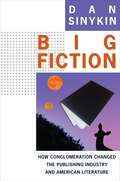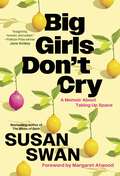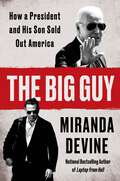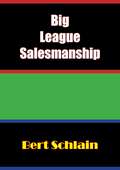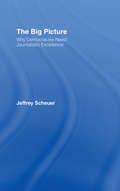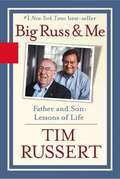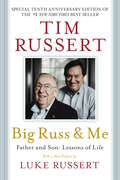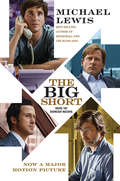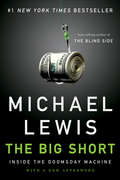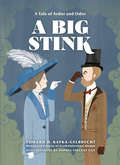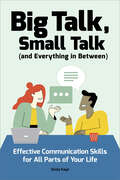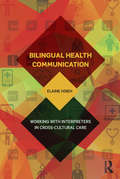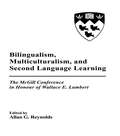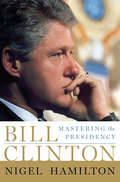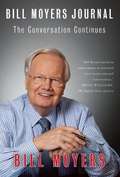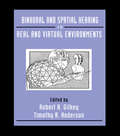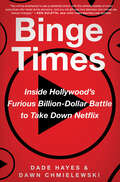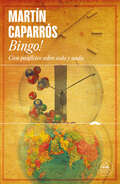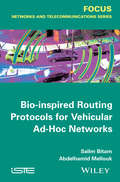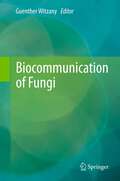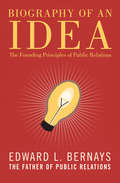- Table View
- List View
Big Fiction: How Conglomeration Changed the Publishing Industry and American Literature (Literature Now)
by Dan SinykinIn the late 1950s, Random House editor Jason Epstein would talk jazz with Ralph Ellison or chat with Andy Warhol while pouring drinks in his office. By the 1970s, editors were poring over profit-and-loss statements. The electronics company RCA bought Random House in 1965, and then other large corporations purchased other formerly independent publishers. As multinational conglomerates consolidated the industry, the business of literature—and literature itself—transformed.Dan Sinykin explores how changes in the publishing industry have affected fiction, literary form, and what it means to be an author. Giving an inside look at the industry’s daily routines, personal dramas, and institutional crises, he reveals how conglomeration has shaped what kinds of books and writers are published. Sinykin examines four different sectors of the publishing industry: mass-market books by brand-name authors like Danielle Steel; trade publishers that encouraged genre elements in literary fiction; nonprofits such as Graywolf that aspired to protect literature from market pressures; and the distinctive niche of employee-owned W. W. Norton. He emphasizes how women and people of color navigated shifts in publishing, arguing that writers such as Toni Morrison allegorized their experiences in their fiction.Big Fiction features dazzling readings of a vast range of novelists—including E. L. Doctorow, Judith Krantz, Renata Adler, Stephen King, Joan Didion, Cormac McCarthy, Chuck Palahniuk, Patrick O’Brian, and Walter Mosley—as well as vivid portraits of industry figures. Written in gripping and lively prose, this deeply original book recasts the past six decades of American fiction.
Big Girls Don't Cry: A Memoir About Taking Up Space
by Susan Swan“[Swan’s writing offers] not only an enjoyable read, but also the chance to think and reflect on the vast complex living entity that is the world." —Nobel Prize-winner Olga TokarczukWhere do we belong if we don’t fit in?A memoir about what it means to defy expectations as a woman, a mother and an artist, for readers of Joan Didion and Gloria Steinem and listeners of the podcast Wiser than MeSusan Swan has never fit inside the boxes that other people have made for her—the daughter box, the wife box, the mother box, the femininity box. Instead, throughout her richly lived, independent decades, she has carved her own path and lived with the consequences.In this revealing and revelatory memoir, Swan shares the key moments of her life. As a child in a small Ontario town, she was defined by her size—attracting ridicule because she was six-foot-two by the age of twelve. She left her marriage to be a single mother and a fiction writer in the edgy, underground art scene of 1970s Toronto. In her forties, she embraced the new freedom of the Aphrodite years. Despite the costs to her relationships, Swan kept searching for the place she fit, living in the literary circles of New York while seeking pleasure and spiritual wisdom in Greece, and culminating in the hard-won experience of true self-acceptance in her seventies.Swan examines the expectations of women of her generation and beyond using the lens of her then-unusual height as a metaphor for the way women are expected not to take up space in the world. Inspiring and thought-provoking, Big Girls Don’t Cry invites us to re-examine what we’ve been taught to believe about ourselves and ask how it could be different.
The Big Guy: How a President and His Son Sold Out America
by Miranda DevineThe New York Post columnist, Fox News contributor, and national bestselling author of Laptop from Hell returns with the explosive, definitive account of the Biden family scandals. It’s rare that a campaign season has anything like an IRS whistleblower and a California US attorney saying they were blocked from pursuing charges, foreign wire transfers of millions of dollars going to several members of politician’s family, suspicious slap-on-the-wrist plea deals, mounds of incrimination texts, a previously unacknowledged child with a stripper, and multiple congressional investigations. It’s unprecedented to have them all tied to one politician like Joe Biden.The federal government and the mainstream media have been selling the narrative for years that Hunter Biden is a good son with addiction problems who has suffered enough. But what if the Biden family has been involved in sketchy financial dealings and coverups that get bigger every passing year?Miranda Devine goes deep into the dark underbelly of American politics, where it’s okay to break the law as long as you follow the rest of the elite’s rules. With a surgeon’s precision she dissects the shady dealings of the Biden family in China and Eastern Europe, exposing the cover-up within the government and media. With meticulous research and insider sources, Devine uncovers the shocking truth about Joe Biden's involvement in his son Hunter's business dealings and the extent of their corruption.Many have argued that intelligence agents and social media companies tilted the 2020 election in Biden’s favor by hiding the contents of Hunter’s laptop. Devine goes beyond their coverage to “silence the truth” and in The Big Guy finally reveals the corruption within the Biden family and the government.
Big-League Salesmanship
by Bert H. SchlainTechniques that RAISE YOUR SCORE IN SELLINGHow a Big League salesman plans his time, builds a prospects interested proves his points.How a Big League salesman sizes up his prospects, appeals to their self-interest, makes his product look indispensable.How a Big League salesman turns complaints into reorders, finds leads everywhere, builds his own public relations program.How a Big League salesman finds out important information, gets ready for an interview, gets "over the fence" to his sale.How to give yourself a 25 per cent raise--right awayHow to make money in the first 30 seconds of a callHow to make appointments that people are glad to keepHow to make your sale 50 per cent sure--before your interviewHow to turn "I can get it cheaper" into "I'll buy now"How to turn and objection into a reason to buy nowHow to make it easy for your prospect to sell himselfHow to show extra value in anything you sellHow to build a hard-hitting presentationHow to develop the will to winHERE IS a treasure-chest of professional selling techniques, written for the man who has his eye on more sales, more income, and steady advancement.In this clearly written book you will find sure techniques for developing prospects--ways to open doors that rarely open. You will see how to give a really effective sales presentation, close a sale, make one sale lead to another--build steady, profitable accounts. Each chapter points out not only what to do but tells you how to do it.As a "refresher course" for the veteran or as an eye-opener for the rookie, big league salesmanship builds your ability, confidence and enthusiasm...gives you the know-how that backs up every sale.
The Big Picture: Why Democracies Need Journalistic Excellence
by Jeffrey ScheuerFreedom of the press is the cornerstone of democracy. But, as countless recent examples of lapsed standards in the press since the Jayson Blair affair have shown, the First Amendment is no guarantee that American journalism will be first-rate. A press in crisis is a democracy endangered, argues Jeffrey Scheuer--cultural critic and author of The Sound Bite Society. In his new book, The Big Picture, Scheuer argues that in order for a democracy to thrive it is not enough for its press simply to be free--the press must be exceptional. This book explores journalistic excellence and its essential relationship with democracy, explaining why democracies depend on it and are only as good as their journalism. In The Big Picture, Scheuer explores journalistic excellence from three broad perspectives. First, from the democratic perspective, he shows how journalism is a core democratic function, and journalistic excellence a core democratic value. Then, from an intellectual perspective, he explores the ways in which journalism addresses basic concepts of truth, knowledge, objectivity, and ideology. Finally, from an institutional perspective, he considers the role and possible future of journalism education, the importance of journalistic independence, and the potential for nonprofit journalism to meet the journalistic needs of a democratic society. In lucid and accessible prose, The Big Picture provocatively demonstrates why we must all be vigilant about the quality of journalism today.
Big Russ and Me: Lessons of Life
by Tim RussertRussert looks back fondly to his 1950s Buffalo neighborhood of his youth and recalls the extraordinary example of his father, a WWII veteran who worked 2 jobs for 30 years without complaint, and taught his children to appreciate the values of self-discipline, of respect, and of loyalty to friends and family. Russert gives us reason to laugh, cry, and identify with the lessons of life taught by the indomitable Big Russ.
Big Russ and Me: Father & Son: Lessons of Life
by Tim Russert Luke RussertOver the last two decades, before his death in 2008 at the age of 58, Tim Russert had become one of the most trusted and admired figures in American television journalism. Throughout his career he spent time with presidents and popes, world leaders and newsmakers, celebrities and sports heroes, but one person stood out to him in terms of his strength of character, modest grace and simple decency--Russert’s dad, Big Russ. In this warm, engaging memoir, a #1 New York Times bestseller upon its initial release in 2004, Russert casts a fond look back to the 1950s Buffalo neighborhood of his youth. In the close-knit Irish-Catholic community where grew up, doors were left unlocked at night; backyard ponds became makeshift ice hockey rinks in winter; and streets were commandeered as touch football fields in the fall. And he recalls the extraordinary example of his father, a WWII veteran who worked two jobs without complaint for thirty years and taught his children to appreciate the values of self-discipline, of respect, of loyalty to friends. These deep roots stayed with Russert as he forged a remarkable career, first in government and then in media, and finally in his 16 years at Meet the Press as one of the most recognized and trusted face in television news. As Russert explains, his fundamental values sprung from that small house on Woodside Avenue and the special bond he shared with his father--values he passed down to his own son, Luke. As Tim Russert celebrates the indelible connection between fathers and sons, readers everywhere will laugh and cry in identification with the life lessons of Big Russ and in mourning of Tim Russert, a big American voice in his own right. For this special 10th anniversary trade paperback edition of Big Russ & Me, Tim’s son Luke will contribute an extensive introduction, commenting on his father’s legacy, and on how these lessons passed down from his grandfather impact the third generation. Luke had just graduated from college in 2008 when his father passed away. Since then, he has followed in his father’s footsteps, working as a special correspondent and congressional reporter for NBC news and contributing frequently to various NBC and MSNBC outlets. Despite his youth, Luke has already shown that the ideals promoted by Big Russ in midcentury Buffalo still apply in 21st century New York, and that these lessons are as relevant for us as ever.
The Big Short: Inside the Doomsday Machine (movie tie-in) (Movie Tie-in Editions)
by Michael LewisThe #1 New York Times bestseller--Now a Major Motion Picture from Paramount Pictures From the author of The Blind Side and Moneyball, The Big Short tells the story of four outsiders in the world of high-finance who predict the credit and housing bubble collapse before anyone else. The film adaptation by Adam McKay (Anchorman I and II, The Other Guys) features Academy Award® winners Christian Bale, Brad Pitt, Melissa Leo and Marisa Tomei; Academy Award® nominees Steve Carell and Ryan Gosling. When the crash of the U.S. stock market became public knowledge in the fall of 2008, it was already old news. The real crash, the silent crash, had taken place over the previous year, in bizarre feeder markets where the sun doesn't shine and the SEC doesn't dare, or bother, to tread. Who understood the risk inherent in the assumption of ever-rising real estate prices, a risk compounded daily by the creation of those arcane, artificial securities loosely based on piles of doubtful mortgages? In this fitting sequel to Liar's Poker, Michael Lewis answers that question in a narrative brimming with indignation and dark humor.
The Big Short: Inside the Doomsday Machine (Movie Tie-in Editions Ser.)
by Michael LewisThe real story of the crash began in bizarre feeder markets where the sun doesn't shine and the SEC doesn't dare, or bother, to tread: the bond and real estate derivative markets where geeks invent impenetrable securities to profit from the misery of lower- and middle-class Americans who can't pay their debts. The smart people who understood what was or might be happening were paralyzed by hope and fear; in any case, they weren't talking.<P><P> Michael Lewis creates a fresh, character-driven narrative brimming with indignation and dark humor, a fitting sequel to his #1 bestseller Liar's Poker. Out of a handful of unlikely-really unlikely-heroes, Lewis fashions a story as compelling and unusual as any of his earlier bestsellers, proving yet again that he is the finest and funniest chronicler of our time.
A Big Stink: A Tale of Ardor and Odor
by Edward H. Kafka-GelbrechtA delightfully illustrated story about passing gas and passing the buck, by a renowned scholar of gastrointestinal humor who has seen and smelled it all.The marriage of flatulence and wordplay is a potent source of pleasure as old as language itself. So says Edward H. Kafka-Gelbrecht, who has spent a lifetime studying the art of the unclaimed fart, from the courtroom to the convent. Now, in this illustrated tour de force, he airs a more personal story about a quiet elevator ride that is shattered by an ignoble gas. Starting with the classic &“He who smelt it, dealt it&” and the indignant riposte &“She who denied it, supplied it,&” the repartee heats up as the elevator rises. Can a reek that drives people apart instead bring two hearts together? A Big Stink&’s beguiling blend of highbrow and lowbrow humor will delight oversharing families and word lovers alike. Illustrator Sophia Vincent Guy ramps up the fun with elegantly detailed illustrations sprinkled with Easter eggs. Sure to reduce even the most solemn adults to irrepressible giggles, A Big Stink is a ripping good read and a breath of foul air.
Big Talk, Small Talk (and Everything in Between): Effective Communication Skills for All Parts of Your Life
by Shola KayeLearn the art of effective communication with skill-building strategies and tools Effective communication doesn't come naturally to everyone, but the good news is you can get better at it with practice and the right tools. Big Talk, Small Talk (and Everything in Between) is filled with strategies to help you build communication skills and put them into practice in everyday interactions with friends, family, work colleagues, acquaintances, and even strangers. Communicating effectively can create opportunities in your life, foster relationships that wouldn't have existed otherwise, and smooth over awkward or stressful interactions. Learn how to make engaging small talk and incisive big talk, translate body language and facial expressions, and improve visual and written skills. You'll find practical tips that help you get the most out of each strategy, scenarios that illustrate each technique in practice, and more. This book for building effective communication skills includes: Communication 101—Learn about the social importance of effective communication skills and the different ways we communicate. 46 Skill-building strategies—Discover a wide range of tips and tools to help you establish communication skills for any social situation. Real-life scenarios—Explore a variety of common situations where effective communication skills are important, like sparking up a conversation with a stranger or letting someone know they hurt your feelings. Build strong communication skills with Big Talk, Small Talk (and Everything in Between).
The Biggest Game of All: The Inside Strategies, Tactics, and Temperaments That Make Great Dealmakers Great
by Leslie Cauley Leo Hindery Jr.An uncritical look at the executives behind the largest corporate mergers.
Bild, Realität und Medienkonstruktion: Eine Frame-Analyse der deutschen Mediendarstellungen von China
by Fengmin YanDieses Buch untersucht im Rahmen der Framing-Theorie, wie Nachrichtenmedien soziale Themen und Ereignisse konstruieren und dadurch bestimmte Wahrnehmungen vermitteln. Durch die Operationalisierung des medialen Framings als Interpretationsprozess durch Problemdefinition, Ursachendiagnose, moralische Wertung und Lösungsvorschläge schlägt das Buch einen systematischen und transparenten Ansatz für Bilder im Nachrichtendiskurs vor. Auf der Grundlage einer Frame-Analyse wird untersucht, wie deutsche Nachrichtenmedien eine Liste von Themen und Ereignissen mit China-Bezug rahmen und dadurch bestimmte Überzeugungen und Meinungen über dieses Land vermitteln. Darüber hinaus wird untersucht, ob es dominante Deutungsmuster gab und inwieweit unterschiedliche Sichtweisen erkennbar waren, indem zwei große Tageszeitungen mit gegensätzlicher politischer Ausrichtung - die FAZ und die taz - verglichen werden.Angeregt durch die Beziehung zwischen Bild und Wirklichkeit, untersucht das Buch die Entstehung und das Fortbestehen von Bildern anhand der medialen Konstruktion von Bedeutung und der menschlichen kognitiven Komplexität bei der Wahrnehmung anderer. Medien wählen bestimmte Themen und Ereignisse aus und interpretieren sie dann aus bestimmten Perspektiven. Eine Vielzahl professioneller und nicht-professioneller Faktoren, die hinter der Nachrichtenproduktion stehen, können zu verzerrten Darstellungen führen. Darüber hinaus können aus sozialpsychologischer Sicht ungenaue Wahrnehmungen fremder Kulturen durch kategorisches Denken, verzerrte Verarbeitung von Stimulusinformationen, Interessenkonflikte zwischen Gruppen und Bevorzugung der eigenen Gruppe entstehen.Dementsprechend geht es in diesem Buch nicht in erster Linie darum, ob die Medienberichterstattung von der Realität abweicht, sondern vielmehr um die zugrunde liegende Logik, auf der die Schlussfolgerungen und Urteile beruhen. Es trägt daher zu einem rationalen Verständnis des westlichen Diskurses bei und hat praktische Auswirkungen sowohl auf die chinesische öffentliche Diplomatie als auch auf eine konstruktivere Rolle der Nachrichtenmedien bei der Förderung des Verständnisses für andere.
Bildverarbeitung in der Automation: Ausgewählte Beiträge des Jahreskolloquiums BVAu 2022 (Technologien für die intelligente Automation #17)
by Volker LohwegIn diesem Open-Access-Tagungsband sind die besten Beiträge des 8. Jahreskolloquiums "Bildverarbeitung in der Automation" (BVAu 2022) enthalten. Das Kolloquium fand am 02. November 2022 auf dem Innovation Campus Lemgo statt.Die vorgestellten neuesten Forschungsergebnisse auf den Gebieten der industriellen Bildverarbeitung erweitern den aktuellen Stand der Forschung und Technik. Die in den Beiträgen enthaltenen anschaulichen Anwendungsbeispiele aus dem Bereich der Automation setzen die Ergebnisse in den direkten Anwendungsbezug.
Bilingual Health Communication: Working with Interpreters in Cross-Cultural Care
by Elaine HsiehThis book examines interpreter-mediated medical encounters and focuses primarily on the phenomenon of bilingual health care. It highlights the interactive and coordinated nature of interpreter-mediated interactions. Elaine Hsieh has put together over 15 hours of interpreter-mediated medical encounters, interview data with 26 interpreters from 17 different cultures/languages, 39 health care providers from 5 clinical specialties, and surveys of 293 providers from 5 clinical specialties. The depth and richness of the data allows for the presentation of a theoretical framework that is not restricted by language combination or clinical contexts. This will be the first book of its kind that includes not only interpreters’ perspectives but also the needs and perspectives of providers from various clinical specialties. Bilingual Health Communication presents an opportunity to lay out a new theoretical framework related to bilingual health care and connects the latest findings from multiple disciplines. This volume presents future research directions that promise development for both theory and practice in the field.
Bilingualism, Multiculturalism, and Second Language Learning: The Mcgill Conference in Honour of Wallace E. Lambert
by Allan G. ReynoldsThis collection pays tribute to Professor Wallace E. Lambert and his contributions to the fields of language and linguistics. Each chapter, written by an internationally renowned theorist or researcher, traces the currents of theory and research within the topic area to the present day, provides a state-of-the-art review of the topic, and offers an outline for future research directions. The book concludes with an overview from Professor Lambert that critically examines the impact of the ideas in each individual chapter. This volume is organized around the three areas where Professor Lambert's unique contributions are most substantial and most evident: bilingualism, multiculturalism, and second language learning. Specifically, the papers presented discuss the topics of social, psychological, cognitive, and neuropsychological aspects of bilingualism and second language learning, the psychology of inter-group relations and multiculturalism, bilingual/immersion education, and language planning. Note: Royalties earned from sales of this book will go to the Wallace E. Lambert Student Research Fund at McGill University for use by students interested in second language acquisition, bilingualism, and/or multiculturalism.
Bill Clinton: Mastering the Presidency
by Nigel HamiltonFrom best-selling, award-winning biographer Nigel Hamilton, this is an insightful, prodigiously researched, and wonderfully readable account of Bill Clinton’s first term in office. It shows how a well-meaning but naïve new president failed to assert true leadership in his first two years, and then illustrates how, in an astonishing act of self-reinvention, the president turned defeat into victory. Bill Clinton: Mastering the Presidency is a gripping tale of hubris and redemption-and a chronicle of one of the most dramatic reversals of fortune in modern American politics.
Bill Moyers Journal: The Conversation Continues
by Bill MoyersOne of the most highly rated public affairs programmes on American television, Bill Moyers' Journal drew up to two million weekly viewers from 2007 to 2010. With incisive, morally engaging text, this stunning companion brings Moyers' groundbreaking work to the page. Featuring extensive new commentary from Bill Moyers, it is an unparalleled guide to the debates, the cultural currents and above all the fascinating people that have so powerfully shaped today's world.
Binaural and Spatial Hearing in Real and Virtual Environments
by Robert H. Gilkey Timothy R. AndersonThe current popular and scientific interest in virtual environments has provided a new impetus for investigating binaural and spatial hearing. However, the many intriguing phenomena of spatial hearing have long made it an exciting area of scientific inquiry. Psychophysical and physiological investigations of spatial hearing seem to be converging on common explanations of underlying mechanisms. These understandings have in turn been incorporated into sophisticated yet mathematically tractable models of binaural interaction. Thus, binaural and spatial hearing is one of the few areas in which professionals are soon likely to find adequate physiological explanations of complex psychological phenomena that can be reasonably and usefully approximated by mathematical and physical models. This volume grew out of the Conference on Binaural and Spatial Hearing, a four-day event held at Wright-Patterson Air Force Base in response to rapid developments in binaural and spatial hearing research and technology. Meant to be more than just a proceedings, it presents chapters that are longer than typical proceedings papers and contain considerably more review material, including extensive bibliographies in many cases. Arranged into topical sections, the chapters represent major thrusts in the recent literature. The authors of the first chapter in each section have been encouraged to take a broad perspective and review the current state of literature. Subsequent chapters in each section tend to be somewhat more narrowly focused, and often emphasize the authors' own work. Thus, each section provides overview, background, and current research on a particular topic. This book is significant in that it reviews the important work during the past 10 to 15 years, and provides greater breadth and depth than most of the previous works.
Binge Times: Inside Hollywood's Furious Billion-Dollar Battle to Take Down Netflix
by Dade Hayes Dawn ChmielewskiThe first comprehensive account of the biggest wake-up call in the history of the entertainment business: the pivot to streaming. Go inside a disparate group of media and tech companies -- Disney, Apple, AT&T/WarnerMedia, Comcast/NBCUniversal and well-funded startup Quibi – as they scramble to mount multi-billion-dollar challenges to Netflix.After spotting Netflix and the deep-pocketed Amazon Prime Video a decade’s head start, rivals from the tech and start-up realm (Apple, Quibi) and traditional media (Disney, WarnerMedia, NBCUniversal) all decided to move mountains to enter the streaming game. At a cost of billions, each went after their own piece of the market, launching five new services in a seven-month span. And just as the derby was heating up, the coronavirus pandemic arrived, a black-swan event bringing short-term benefits but also stiff challenges.The battle for streaming supremacy may end up having more than one winner, but the cost and disruption to decades-old business models have also produced a lot of losers. Binge Times reveals the true costs of the vision quest as companies are turned inside-out and repeatedly redraw their org charts and strategic plans. Stretching from Silicon Valley to Hollywood to Wall Street, it is a mesmerizing, character-rich tale of hubris and ambition, as the fate of a century-old industry hangs in the balance.
Bingo!
by Martín CaparrósObservaciones, pensamientos e ideas a propósito de los números, desde el 00 al 99. Sucesos históricos, supersticiones, la actualidad, la política, el mundo. Originalmente publicados en forma semanal en las revistas Veintidós y Veintitrés. Al principio fue un desafío: «Ahora que cumplimos 69 números, a que no te atrevés a escribir una columna sobre el número 69», le dijo el editor de Veintitrés, la revista donde entonces escribía. Caparrós lo hizo, por supuesto, y después pensó que por qué no el 70 y el 71 y el 72 y así de seguido, hasta llenar el álbum de las cifras de dos dígitos. Escritos al calor del nuevo milenio, los cien ensayos breves de este libro terminan siendo tan imprevisibles como un dado lanzado al azar. Del 00 al 99, esta especie de cábala de temas urgentes, argentinos o mundiales, políticos, sociales, filosóficos es quizás el libro más original de Martín Caparrós, el que lo elevó a la categoría de gran contador de historias. Críticas:«Caparrós construye una serie heterogénea en temas y saberes, y halla en su plan numérico tanto la sujeción que las reminiscencias insalvables de algunas cifras le imponen como la libertad para referir el hallazgo de cualquier cosa que otras le permiten».Patricio Lennard, Radar, Página/12 «Caparrós es una manera de ver y entender el mundo».Carles Geli, Babelia«Martín Caparrós, uno de los más geniales cronistas contemporáneos, depura de manera exquisita, emocionada, vibrante y distanciada una prosa de un poderío narrativo excepcional».Fernando R. Lafuente, ABC Cultural «Un perturbador sistemático, un sembrador de dudas».Francesca Lazzarato, Il Manifesto«Su prosa y su mirada son un reactivo fuerte para almas sensibles o amigas de lo políticamente correcto».Leila Guerriero, El País «Convence tanto como seduce».Edmundo Paz Soldán, La Tercera
Bio-inspired Routing Protocols for Vehicular Ad-Hoc Networks
by Salim Bitam Abdelhamid MelloukVehicular Ad-Hoc Networks (VANETs) play a key role to develop Intelligent Transportation Systems (ITS) aiming to achieve road safety and to guaranty needs of drivers and passengers, in addition to improve the transportation productivity. One of the most important challenges of this kind of networks is the data routing between VANET nodes which should be routed with high level of Quality of Service (QoS) to ensure receiving messages in the time. Then, the driver can take the appropriate decision to improve the road safety. In the literature, there are several routing protocols for VANETs which are more or less reliable to reach safety requirements. In this book, we start by describing all VANET basic concepts such as VANET definition, VANET versus Mobile ad-Hoc Network (MANET), architectures, routing definition and steps, Quality of Service (QoS) for VANET Routing, Metrics of evaluation, Experimentation, and simulation of VANETs, mobility patterns of VANET etc. Moreover, different routing protocols for routing in VANETs will be described. We propose two main categories to be presented: classical routing and bio-inspired routing. Concerning classical VANET, main principles and all phases will be overviewed, as well as, their two sub-categories which are topological and geographical protocols. After that, we propose a new category called bio-inspired routing which is inspired by natural phenomenon such as Ant colony, Bee life, Genetic operators etc. We present also, some referential protocols as example of each category. In this book, we focus on the idea of how to apply bio-inspired principle into VANET routing to improve road safety, and to ensure QoS of vehicular applications.
Biocommunication of Fungi
by Günther WitzanyFungi are sessile, highly sensitive organisms that actively compete for environmental resources both above and below the ground. They assess their surroundings, estimate how much energy they need for particular goals, and then realise the optimum variant. They take measures to control certain environmental resources. They perceive themselves and can distinguish between 'self' and 'non-self'. They process and evaluate information and then modify their behaviour accordingly. These highly diverse competences show us that this is possible owing to sign(aling)-mediated communication processes within fungal cells (intraorganismic), between the same, related and different fungal species (interorganismic), and between fungi and non-fungal organisms (transorganismic). Intraorganismic communication involves sign-mediated interactions within cells (intracellular) and between cells (intercellular). This is crucial in coordinating growth and development, shape and dynamics. Such communication must function both on the local level and between widely separated mycelium parts. This allows fungi to coordinate appropriate response behaviors in a differentiated manner to their current developmental status and physiological influences.
Bioethics Mediation: A Guide to Shaping Shared Solutions
by Nancy Dubler Carol LiebmanProvides the conceptual framework supporting the need for mediation in the medical context
Biography of an Idea: The Founding Principles of Public Relations
by Edward L. BernaysThe father of public relations looks back on a landmark life spent shaping trends, preferences, and general opinion A twentieth-century marketing visionary, Edward L. Bernays brilliantly combined mastery of the social sciences with a keen understanding of human psychology to become one of his generation's most influential social architects. In Biography of an Idea, Bernays traces the formative moments of his career, from his time in the Woodrow Wilson administration as one of the nation's key wartime propagandists to his consultancy for such corporate giants as Procter & Gamble, General Electric, and Dodge Motors. While working with the American Tobacco Company, Bernays launched his now-infamous Lucky Strike campaign, which effectively ended the long-standing taboo against women smoking in public. With his vast knowledge of the psychology of the masses, Bernays was in great demand, advising high-profile officials and counseling the tastemakers of his generation. His masterful and at times manipulative techniques had longstanding influences on social and political beliefs as well as on cultural trends. Biography of an Idea is a fascinating look at the birth of public relations--an industry that continues to hold sway over American society.
